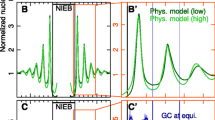Abstract
Proteins, on binding to a DNA sequence, alter the frequency and quality of mutations that occur in the sequence. This represents a reverse flow of information from proteins to DNA. Nucleosome binding causes patterns of UV-induced damage which, when converted to mutations by replication, will phase nucleosomes. We propose that DNA binding proteins create their own high- or low-affinity binding sites along DNA sequences by biased mutational pressure.
Similar content being viewed by others
References
Becker MM, Grossman G (1992) Photofootprinting DNA in vitro. Methods Enzymol 212:262–272
Boulikas T (1992) Evolutionary consequences of nonrandom damage and repair of chromatin domains. J Mol Evol 35:156–180
Collins DW, Jukes TH (1993) Relationship between G + C in silent sites of codons and amino acid composition of human proteins. J Mol Evol 36:201–213
Filipski J (1989) Evolution of DNA sequence contributions of mutational bias and selection to the origin of chromosomal compartments, In: Obe G (ed) Advances in mutagenesis research 2. Springer-Verlag, Berlin, p 1–54
Gale JM, Smerdon MJ (1988) Photofootprint of nucleosome core DNA in intact chromatin having different structural states. J Mol Biol 204:949–958
Gale JM, Smerdon MJ (1990) UV induced (6–4) photoproducts are distributed differently than cyclobutane dimers in nucleosomes. Photochem Photobiol 51:411–417
Hayes TJ, Tullius TD, Wolfee AP (1990) The structure of DNA in a nucleosome. Proc Natl Acad Sci USA 87:7405–7409
Holmquist GP (1990) Mutational bias, molecular ecology, and chromosome evolution, In: Obe G (ed) Advances in mutagenesis research 2. Springer Verlag, Berlin, p 95–126
Holmquist GP, Filipski J (1994) Organization of mutations along the genome: a prime determinant of genome evolution. Trends Ecol Evol 9:65–69
Ioshikhes I, Bolshoy A, Trifonov EN (1992) Preferred positions of AA and TT dinucleotides in aligned nucleosomal DNA sequences. J Biomolec Struct Dyn 9:1111–1117
Ljungman M, Nyberg S, Nygren J, Eriksson M, Ahnstrom G (1991) DNA bound proteins contribute much more than soluble intracellular compounds to the intrinsic protection against radiation-induced DNA strand breaks in human cells. Raidiat Res 127:171–176
Pfeifer GP, Drouin R, Riggs AD, Holmquist GP (1991) Binding of transcription factors creates hot spots for UV photoproducts in vivo. Mol Cell Biol 12:1798–1804
Pherson JR, Cohen LH (1992) Effects of DNA looping on pyrimidine dimer formation. Nucleic Acids Res 20:1321–1324
Satchwell SC, Drew HR, Travers AA (1986) Sequence periodicities in chicken nucleosome core DNA. J Mol Biol 191:659–675
Sueoka N (1988) Directional mutation pressure and neutral molecular evolution. Proc Natl Acad Sci U S A 85:2653–2657
Tachida H (1990) A population genetic model of selection that maintains specific trinucleotides at a specific location. J Mol Evol 31:10–17
Thoma F (1992) Nucleosome positioning. Biochim Biophys Acta 1130:1–19
Travers AA, King A (1987) The bending of DNA in nucleosomes and its wider implications. Philos Trans R Soc Lond Biol 317:537–561
Turker MS, Cooper GE, Bishop PL (1993) Region-specific rates of molecular evolution: a fourfold reduction in the rate of accumulation of “silent” mutations in transcribed versus nontranscribed regions of homologous DNA fragments derived from two closely related mouse species. J Mol Evol 36:31–40
Author information
Authors and Affiliations
Rights and permissions
About this article
Cite this article
Holmquist, G.P. Chromatin self-organization by mutation bias. J Mol Evol 39, 436–438 (1994). https://doi.org/10.1007/BF00173411
Received:
Accepted:
Issue Date:
DOI: https://doi.org/10.1007/BF00173411




